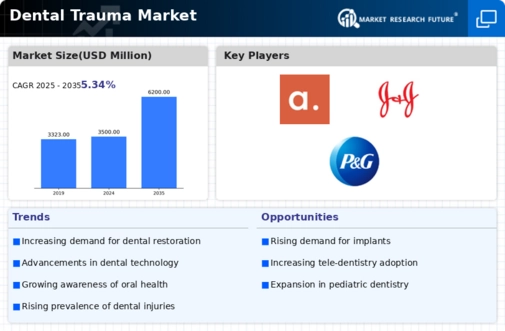Market Trends
Key Emerging Trends in the Dental Trauma Market
Due to the prevalence of tooth injuries worldwide, dental trauma trends are evident. Most dental trauma cases are caused by falls, sports injuries, and accidents, requiring fast and effective dental treatment. Dental imaging technology is changing market dynamics. Digital radiography and high-resolution cone-beam computed tomography (CBCT) scans increase dental trauma diagnostic accuracy and speed, enabling targeted treatment. Dental practitioners benefit from improved patient outcomes and faster processes. Sports dentistry is getting increased attention due to sports-related dental injuries. Sports teams, coaches, and players are understanding the need of early dental care for damage and prevention. This raises sports mouthguard, protective gear, and oral trauma treatment demand, which impacts the market. Market trends include childhood dental trauma. Children and teenagers are particularly susceptible to oral damage due to their hectic schedules. Due to early intervention and kid-friendly dental trauma treatment, the dental trauma industry is evolving. Cosmetic dentistry, especially for visible tooth damage, is affecting dental trauma sales. Patients seeking cosmetic treatments including crowns, bonding, and veneers after dental injury want natural-looking teeth. This pattern reflects a trend toward cosmetic dentistry. New dental materials and repair technologies improve dental trauma treatment. After dental injury, biocompatible materials, improved bonding agents, and less intrusive restoration processes provide more durable and attractive outcomes. Teledentistry is affecting the dental trauma industry by offering distant consultations and dental emergency triage. Teledentistry lets patients instantaneously connect with dental professionals for early exams and oral injury management. Patient education and awareness affect dental trauma market trends. Dental practitioners and organizations focus on public education about dental trauma symptoms, prevention, and treatment. Preventing oral injuries reduces their severity and long-term repercussions. Organizations, academics, and dentists collaborate to study oral trauma therapy. Standardization of treatment processes, standards, and best practices enhances consistency and quality of service worldwide, advancing the dental trauma industry. Insurance coverage and payment criteria affect dental trauma treatment accessibility. When dental trauma interventions are reimbursed, dentists are incentivized to treat quickly and thoroughly. Addressing cost and enhancing patient access to important treatments influences market dynamics.






Leave a Comment